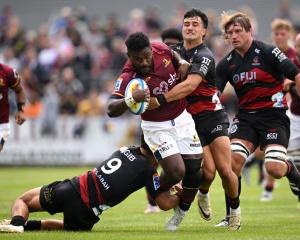
There are now almost 28,000 registered female rugby players in New Zealand, which equates to a 14.5% rise on last year.
It also means the number of females playing rugby in New Zealand has almost doubled since 2012 and from making up just nine per cent of the total playing base, women now account for almost 18% of all rugby players in New Zealand.
What is perhaps most significant is that the growth was across all age groups, but particularly in the junior ranks. The number of girl Small Blacks - aged five to 12 - grew 15%. The overall growth in Small Blacks numbers was 2.6%.
New Zealand Rugby head of women's rugby development Cate Sexton said several factors had helped drive the growth. Partly it could be attributed to a greater financial investment in the women's game by NZR, while the continued success of the Black Ferns and Black Ferns Sevens had also helped.
The Black Ferns Sevens have become arguably the more compelling of the two national sevens sides to follow. Their epic Commonwealth Games final against Australia in April was about the most entertaining 25 minutes of rugby this year.
The game went to extra time before a breath-taking solo try by Kelly Brazier decided things. The Black Ferns, too, have captured the imagination of the nation following their World Cup victory last year which saw them battle it out with England in a classic final.
Their recent test against the Wallaroos won a TV audience of 526,000, making them one of the bigger sporting entities in the country.
"Following our double-digit growth last year, these figures show there is a real generational shift going on in our game and it's great to see so many young girls being inspired to give rugby a go," said Sexton.
"The biggest area of growth was in our youngest demographic, with a more than 15% increase in Small Blacks, so the future is very bright.
"I have no doubt many of them have been inspired by the success of our Black Ferns and Black Ferns Sevens teams and the example they are setting on and off the field.
"New Zealand Rugby and the provincial unions have put more resources into women's rugby and that's paying off. We have seen Molenberg come on board with a historic sponsorship of our Black Ferns and Black Ferns Sevens and the recent television viewership figures for the Laurie O'Reilly tests highlighted the growing public interest."
Overall playing numbers were up 1% to 157,218 and again the biggest area of concern for NZR is teenagers who continue to walk away from rugby. There was a 4.8% drop in the 13-20 age bracket, which contributed to an overall drop of 1.8% among male participation.
New Zealand Rugby head of participation Steve Lancaster said: "It's great to see so much diversity in our game across age, gender and ethnicity and we are seeing some real growth in new non-contact forms of rugby including Rippa Rugby and Quick Rip.
"However, there is no doubt the world has changed and young people particularly have a lot of choices."












